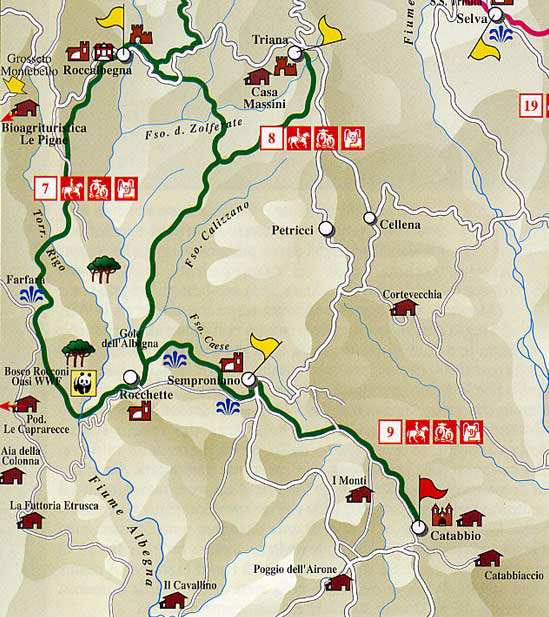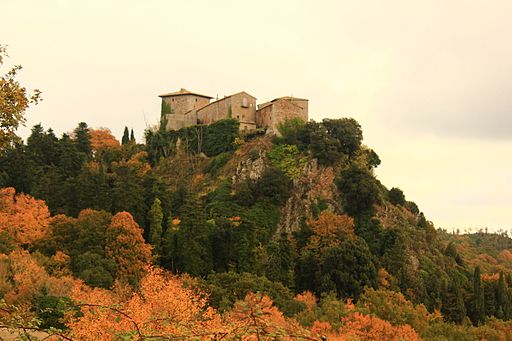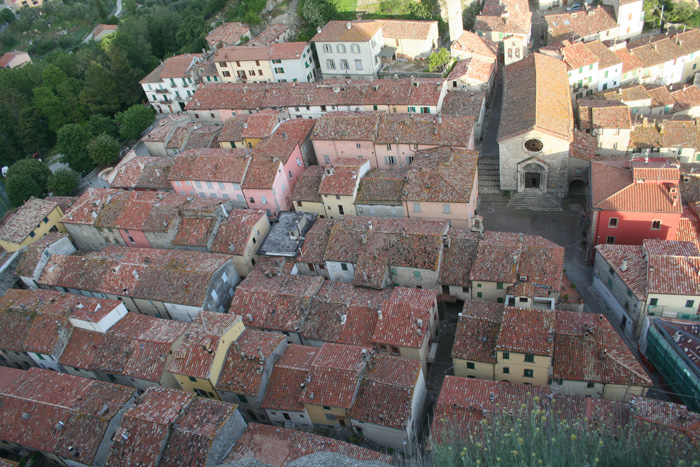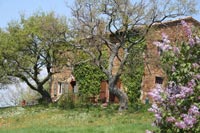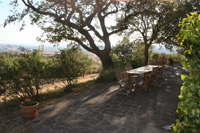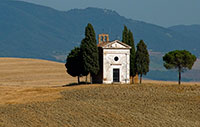| |
|
The area around Roccalbegna offers some lovely walks among the various nature reserves. Near Roccalbegna, the 1800-acre Riserva Naturale Monte Labbro spreads over the southwesterly slopes of Monte Amiata, offering a spectacular view of the of the typical Tuscan landscape.
Semproniano - Roccalbegna - Triana | sentiero 8
This pathway is parallel to the pathway n. 7, but it goes along the eastern side. Starting from Semproniano, it climbs down towards the Rocchette, shares a stretch of the pathway number 7 and then it crosses the Calizzano torrent and reaches first the Podere Pezzano and secondly, after a long stretch, the Podere Poggio Sorbi. From here, through a branch of about 3 km, the itinerary continues till the Podere Pian dell'Acquaio and finally the Castle of Triana. The other branch of the pathway leads, by contrast, to Roccalbegna.
The itinerary, which is a mixture of white pathways and asphalt roads, has an average altitude of about 600 m and becomes demanding only in the surroundings of Roccalbegna and when crossing the Calizzano Torrent. The stretch between the two villages of Semproniano and Roccalbegna is about 13 km and it can be covered on foot in about two hours, excluding the alternative branch towards Triana.
|
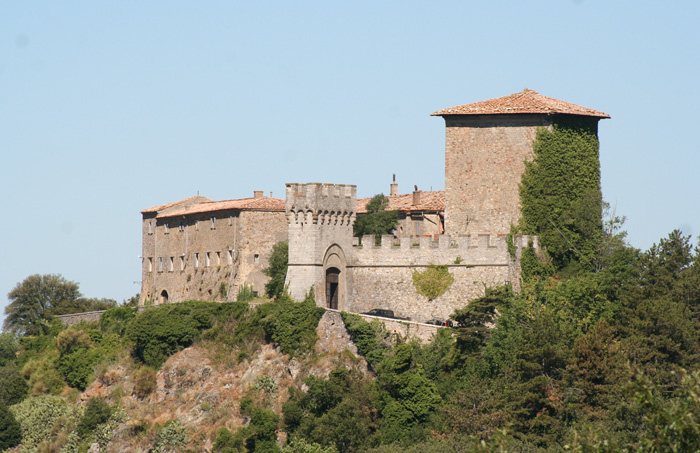 |
Castello di Triana, Roccalbegna
|
Roccalbegna - Semproniano | sentiero 7
|
| The pathway originates in the old town of Roccalbegna and crosses, climbing up and down, a wide stretch of the old Maremma, passing near the localities of Poggio Lago, Podere Rocconi (Reserve of the Rocconi forest), Podere Ceccherino, La Crocina, and returning then, once passed the Albegna, towards Rocchette di Fazio and Semproniano (this last village can be reached from Rocchette even by the asphalt road). The stretch between Rocchette and Semproniano is also shared by the pathway number 8.
This itinerary is a mixture of white pathways and asphalt roads and presents just one demanding stretch, corresponding to the crossing of the Rivo Torrent; the pathway winds up for about 13 km and it can be covered on foot in about 4 hours.
We strongly recommend this itinerary as a unique opportunity to admire the wonderful valley of the Albegna river, which is characterized by some of the most beautiful European canyons, as well as to visit the fascinating old town of Rocchette, rare example of a perfectly maintained medieval village situated on overhanging rocks.
|
Riserva Naturale Pescinello (Pescinello Nature Reserve)
Located on the upper reaches of the Albegna river, the guardians of this reserve are attempting to re-introduce the ‘capovaccaio', a bird of prey. Coming from the Roccalbegna direction, procede for Triana, and after about 2 Km/1.2 miles, take the left turning.
Riserva Naturale di Rocconi (Rocconi Nature Reserve)
Located near the town of Roccalbegna , this reserve is set on the harsh ravine of the Albegna river. It is in part a World Wildlife Fund Oasis and is open year round, but only on a reserved, guided visit basis. Nearby, in the neighboring town of Semproniano, is the Centro Recupero Rapaci (Rescue Center for Birds of Prey).
The Bosco Rocconi Oasis (130 ha) is at the junction between the Albenga
river and its tributary Rigo. It is characterised by impressive
calcareous walls carved by the flowing streams. The less severe slopes
are covered by a deciduous forest once grown for coppicing. The steep
terrain at the foot of the rock walls is covered by a Mediterranean
evergreen forest with secular trees, some of which are of imposing size.
The uneven orography of the area limited human activities during the
centuries preserving this wild land.
Flora and Fauna
Oaks dominate most of the woodland. Wild fruit trees including wild pear and apple trees with amazing blossoms can be observed in spring. A thick undergrowth of common hawthorn, brooms and Erica intertwines with open patches of grassland where 28 species of wild orchids grow. Of particular interest is the flora of the Rocconi crags.
Home to many species of birds of prey, the inaccessible cliffs of Bosco Rocconi are also the preferred nesting site of the rare lanner falcon. The Oasis is also home to many other species including the Peregrine falcon, the Honey Buzzard, and the majestic Short-toed Eagle, as well as the Tawny Owl, the Horned Owl, the Little Owl and the Barn Owl.
Contact Information and Opening Times
Open all year round.
Tours on Sunday only through booking, morning tour at 9.00 a.m. (a second tour at 15.00 only during the daylight saving period).
Guided tours of the Bosco Rocconi Oasis for groups and schools are available daily on booking.
phone number: +39 347/5823441 Local Guide: +39 0564 989115
E-mail: boscorocconi@wwwf.it[1]
WWF Oases
There are over 100 WWF Oases scattered across the country. Unique and of breathtaking beauty, each Oasis protects a small corner of biodiversity, a unique heritage of the colours and sounds of nature!
The network of protected areas covers a wide range of habitats.
They range from the Lagorai Alps to the shores of Torre Salsa in Sicily, from the Mediterranean forest of Monte Arcosu in Sardinia to the Lagoons of Tuscany, and from the last woodlands of the Padania Plain to the Venetian lagoon.
A mosaic of precious and unique habitats ,flora and fauna is forever protected.
Look at the map of the Oases (in italian)
Oasi WWF of Bosco di Rocconi
Map pdf
|
|
|
|

